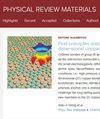Effect of biquadratic magnetic exchange interaction in the 2D antiferromagnets MPS3 (M=Mn,Fe,Co,Ni)
IF 3.1
3区 材料科学
Q2 MATERIALS SCIENCE, MULTIDISCIPLINARY
引用次数: 0
Abstract
The two-dimensional van der Waals (vdW) materials display antiferromagnetic ordering of the magnetic moments at the transition metal ions. The possibility to exfoliate thin layers that preserve the magnetic order makes these materials interesting for numerous applications in devices that require integration of flexible patches of magnetic materials, e.g., in antiferromagnetic spintronics. Hence, an improved understanding of their magnetic properties is desirable. Here, we parametrize spin Hamiltonians for a monolayer of all four materials of this class using density functional theory plus Hubbard calculations. We provide a step-by-step guide for calculating the magnetic exchange interactions and magnetic anisotropy energy using the (non)collinear approach with a suitably chosen for each material. It is found that the biquadratic interactions gain in importance while moving through the series. Retaining the leading terms of a Holstein-Primakoff-transformed spin Hamiltonian, the magnon spectra are calculated. While is found to be an almost isotropic antiferromagnet with a tiny gap, the biquadratic interaction opens an increasingly wider gap for , and . In line with this observation, Monte Carlo simulations demonstrate that the biquadratic interactions contribute to a systematic rise in the Néel temperature from to .

二维反铁磁体 MPS3(M=Mn,Fe,Co,Ni)中的双四边形磁交换相互作用效应
二维范德华(vdW)材料 MPS3(M=Mn,Fe,Co,Ni)显示了过渡金属离子磁矩的反铁磁有序性。由于可以剥离出保持磁序的薄层,这些材料在需要集成灵活的磁性材料贴片的设备(如反铁磁性自旋电子学)中有着广泛的应用前景。因此,我们需要更好地了解它们的磁性能。在这里,我们利用密度泛函理论和哈伯德 U 计算,对该类所有四种材料的单层自旋哈密顿进行了参数化。我们提供了使用(非)对偶 DFT+U(+SOC)方法计算磁交换相互作用和磁各向异性能的分步指南,并为每种材料适当选择了 U。研究发现,在 3d 系列中,双四次方相互作用的重要性不断增加。保留 Holstein-Primakoff 变换自旋哈密顿的前导项,计算了磁子谱。结果发现,MnPS3 几乎是各向同性的反铁磁体,具有微小的间隙,而对于 FePS3、CoPS3 和 NiPS3 来说,双四次方相互作用打开了越来越大的间隙。根据这一观察结果,蒙特卡洛模拟证明,从 FePS3 到 NiPS3,双四次方相互作用导致了内耳温度的系统性上升。
本文章由计算机程序翻译,如有差异,请以英文原文为准。
求助全文
约1分钟内获得全文
求助全文
来源期刊

Physical Review Materials
Physics and Astronomy-Physics and Astronomy (miscellaneous)
CiteScore
5.80
自引率
5.90%
发文量
611
期刊介绍:
Physical Review Materials is a new broad-scope international journal for the multidisciplinary community engaged in research on materials. It is intended to fill a gap in the family of existing Physical Review journals that publish materials research. This field has grown rapidly in recent years and is increasingly being carried out in a way that transcends conventional subject boundaries. The journal was created to provide a common publication and reference source to the expanding community of physicists, materials scientists, chemists, engineers, and researchers in related disciplines that carry out high-quality original research in materials. It will share the same commitment to the high quality expected of all APS publications.
 求助内容:
求助内容: 应助结果提醒方式:
应助结果提醒方式:


